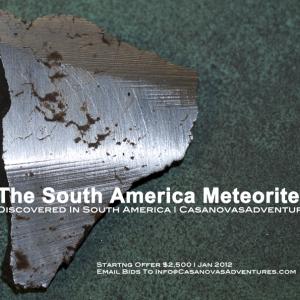College of Liberal Arts & Sciences
8A60.30 - Meteorites
See the instructional resource coordinator for availability.
- Paul Hewitt, "Figuring Physics", TPT, Vol. 32, #8, Nov. 1994, p. 512.
- Alfred O. Nier, "Mass Spectroscopy an Old Field in a New World", TPT, Vol. 5, #1, Jan. 1967, p. 5.
- L. M. Celnikier, "Understanding the Physics of Meteoritic Descent", AJP, Vol. 63, #6, June 1995, p. 524.
- Heather M. Hill, "Giant Meteorites Could Be Responsible for Earth's Continents", Physics Today, Vol. 75, #10, Oct. 2022, p. 16.
- Alex Lopatka, "A Lunar Micrometeorite Preserves the Solar System's Early History", Physics Today, Vol. 75, #5, May, 2022, p. 16.
- Nicholas R. White, "Origins of the Asteroid-Impact Hypothesis", Physics Today, Vol. 74, #6, June 2021, p. 12.
- S. Goderis et al, "Iridium Marks the Spot", Physics Today, Vol. 74, #4, April 2021, p. 64.
- Alex Lopatka, "A Meteorite's Rocky Start", Physics Today, Vol. 74, #1, Jan. 2021, p. 64.
- .Richard J. Fitzgerald, "Origins of Meteorite Organics", Physics Today, Vol. 71, #9, Sept. 2018, p. 76.
- Andrew Grant, "Ancient Meteorite is in a Class of its Own", Physics Today, Vol. 69, #8, Aug. 2016, p. 18.
- R. Mark Wilson, "Giant Impacts May Explain The Origin of Chondrules", Physics Today, Vol. 68, #3, Mar. 2015, p. 14.
- Toni Feder, "Minerals and Meteorites: Searching for New Superconductors", Physics Today, Vol. 67, #5, May 2014, p. 20.
- Steven K. Blau, "A Sharpened Meteor-Impact Dinosaur-Wipeout Connection", Physics Today, Vol. 66, #4, Apr. 2013, p. 20.
- Steven K. Blau, "Earth's Natural Quasicrystals Came from Outer Space", Physics Today, Vol. 65, #10, Oct. 2012, p. 21.
- Barbara Goss Levi, "Chip Off the Old Block: Meteorites are Definitely Linked to Stony Asteroids", Physics Today, Vol. 64, #10, Oct. 2011, p. 12.
- Steven K. Blau, "An Ancient Meteorites Records its Changing Environment", Physics Today, Vol. 64, #5, May 2011, p. 16.
- Mark Wilson, "Meteor Trails Track Upper Atmospheric Winds", Physics Today, Vol. 62, #6, June 2009, p. 16.
- Stephen G. Benka, "New Chemical Clues to Earth-Like Planet Formation", Physics Today, Vol. 61, #7, July 2008, p. 16.
- Mary Beth Griggs, "Yes, A Killer Asteroid Could Hit Earth", Popular Science, Vol. 290, #6, Winter 2018, p. 20.
- Daniel Engber, "How Big Would a Meteorite Have to be to Wipe Out all Human Life?", Popular Science, Vol. 287, #2, Feb. 2015, p. 69.
- Daniel Engber, "FYI: Do Meteor Showers Ever Run Out of Meteors?", Popular Science, Vol. 285, #3, Mar. 2013, p. 81.
- H. J. Melosh, "Acoustic Fluidization", American Scientist, Vol. 71, #2, Mar/Apr. 1983, p. 158.
- Lawrence Grossman, "The Most Primitive Objects in the Solar System", Scientific American, Vol. 232, #2, Feb. 1975, p. 30.
- Joshua Sokol, "Lucky Strike", Science, Vol. 73, #6505, Aug. 2020, p. 760.
- Paul Voosen, "Meteorite Divide Points to Solar System Chaos", Science, Vol. 359, #6383, Mar. 2018, p. 1451.
- T. S. Kruijer, M. Touboul, M. Fischer-Gödde, K. R. Bermingham, R. J. Walker, and T. Kleine, "Protracted Core Formation and Rapid Accretion of Protoplanets", Science, Vol. 344, #6188, June 2014, p. 1150.
- Tim Elliott, "Speed Metal", Science, Vol. 344, #6188, June 2014, p. 1086.
- "This Month in Physics History: July 24, 1954: Operation Moon Bounce", APS News, Vol. 21, #7, July 2012, p. 2, 5.
- "Earth Science 101", Uncle John's Bathroom Reader, p. 82.
- "Random Science", Uncle John's Bathroom Reader, p. 80.
- Jearl Walker, "3.80. Hearing Auroras and Fireballs", The Flying Circus of Physics Ed. 2, p. 177.
- Jearl Walker, "1.37. Curtain of Death of a Meteor Strike", The Flying Circus of Physics Ed. 2, p. 17.
- "Mars Touchstone", Ad Astra, Vol. 25, #1, Spring 2013, p. 18.
- Keith Cowing, "Hitchhiking on a Meteorite: Is There Mars Life on Earth?", Ad Astra, Vol. 14, #3, May/June 2002, p. 34.
- Jeff Hecht, "Global Catastrophes and Mass Extinctions", Analog Science Fiction/Science Fact Magazine, p. 78 - 89.
- D. Tattersfield, "4.12, Meteors", Project & Demonstrations in Astronomy, p. 65 - 68.
- "Greatest Recorded Impact on Earth", Guinness World Records, 2003, p. 77.
- Vagn F. Buchwald, "History and Science of the Campo Del Cielo Meteorite", The Handbook of Iron Meteorites, Vol. 2, 1975.
Disclaimer: These demonstrations are provided only for illustrative use by persons affiliated with The University of Iowa and only under the direction of a trained instructor or physicist. The University of Iowa is not responsible for demonstrations performed by those using their own equipment or who choose to use this reference material for their own purpose. The demonstrations included here are within the public domain and can be found in materials contained in libraries, bookstores, and through electronic sources. Performing all or any portion of any of these demonstrations, with or without revisions not depicted here entails inherent risks. These risks include, without limitation, bodily injury (and possibly death), including risks to health that may be temporary or permanent and that may exacerbate a pre-existing medical condition; and property loss or damage. Anyone performing any part of these demonstrations, even with revisions, knowingly and voluntarily assumes all risks associated with them.
